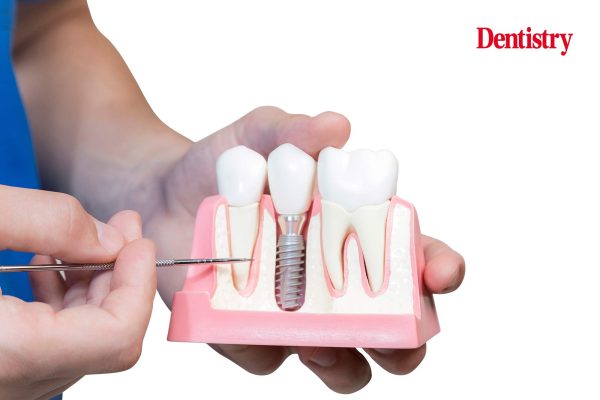Dr Richard Tucker interviews BSP past president, Professor Nikos Donos, on implant dentistry and peri-implantitis.
Recently, the BSP added implant dentistry to its name to reflect more accurately the, now long established, activities of the members and the specialty at large, from training to clinical practice.
Since the early days of Professor Branemark’s contribution to tooth replacement, dental implants are widely within the dental profession.
We know that some implants can last for over 50 years, however not all do. Implants can be a highly successful replacement for teeth. With bone loss around teeth, implants with bone loss can present us, and our patients, with some challenges.
So where are we in our understanding of some of the issues? I posed some questions to our past president:
In assessing the suitability of a patient for implant treatment, how does susceptibility to periodontal inflammation translate to susceptibility to peri-implant inflammation, if at all?
Based on the significant amount of evidence in the literature, today we consider patients treated for periodontal diseases, present with a higher risk for developing peri-implant diseases.
For every day clinical practise, this translates to ensuring of treatment for periodontal disease. Also, that the patient gets placed on an individualised Supportive Periodontal Care (SPC) programme before and after replacement of missing teeth with dental implants.
Furthermore, significant consideration is necessary in relation to the appropriate restorative solutions for periodontitis treated patients.
Much is made of implant surfaces, however the threads by their very nature are biofilm retentive. What challenges does this present when implant threads are exposed in the oral cavity?
Within a clinical setting where treatment of peri-implantitis takes place, we need to expect that exposure of implant threads due to the recession of the peri-implant mucosa may take place, irrespective of the type of implant surface.
Furthermore, the clinician should inform the patient that recession will take place as part of the healing process following treatment of peri-implant diseases.
Whilst implant surfaces are biofilm retentive, in some situations, the exposed threads following treatment of peri-implantitis may be easier to maintain plaque-free, with oral hygiene procedures and SPC.
Unlike around teeth, the thickness and keratinisation of the peri-implant soft tissue is a factor in long-term stability. How important is this in the management of disease?
In the most recent AAP/EFP world consensus conference (American Academy of Periodontology/European Federation of Periodontology), it was concluded that there is ‘unequivocal evidence’ regarding the effect of keratinised mucosa on long-term health of peri-implant tissue.
In different publications though, it suggests that the presence of keratinised mucosa may be advantageous. This is in terms of patient comfort/ease of plaque removal.
What are the main factors to consider in supra-structure design?
There is significant amount of evidence to indicate that a supra-structure design that will allow access for oral hygiene procedures. Also, professional plaque removal during SPC is very important in terms of preventing peri-implant diseases.
Furthermore, a design that will allow a screw retained prosthesis with adequate space for oral hygiene procedures is more favourable than a cement retained one.
How important is supportive peri-implant therapy and what are the key factors to include when managing patients?
Supportive peri-implant therapy should be part of the overall SPC for both periodontitis treated and healthy patients.
Today, the Implant Disease Risk Assessment (IDRA) – a tool for preventing peri-implant disease – has been developed by Heitz-Mayfield and Lang. This includes the most common risk factors that are involved following dental implant placement and restoration.
According to IDRA, the risk factors that should be monitored are:
- History of periodontal disease
- Percentage of sites with bleeding on probing
- Prevalence of PPD more than or equal to five millimetres on implants or teeth
- Periodontal bone loss in relation to age
- Periodontitis susceptibility
- Supportive periodontal therapy
- Distance of the restorative margin of the implant supported prosthesis to the bone
- Implant prosthesis related factors i.e. well- fitting/access for cleaning/screw retained.
In my view, emphasis on the appropriate training of the dental team in identifying and addressing the different risk factors is essential. The educational providers should ensure that these are included in the relevant curricula.
Masterclass
The BSP are running a hands-on masterclass event, presented by Professor Nikos Donos. This takes place on Wednesday 22 June at the Royal College of Surgeons of England, 38 – 43 Lincoln’s Inn Fields, London, WC2A 3PE.
‘Peri-implantitis masterclass: diagnosis and treatment modalities’ will help delegates improve their knowledge and understanding of peri-implant diseases. This includes epidemiological risk factors, clinical diagnosis, therapeutic management and long-term maintenance.
Objectives
- To understand the prevalence, aetiology, pathogenesis, risk factors and clinical presentation of peri-implant diseases
- To appreciate the rationale for non-surgical and surgical management of peri-implantitis
- To understand the relative roles of specialised instruments/equipment, surgical techniques, and biomaterials in the non-surgical and surgical management of peri-implantitis
- To become more proficient in surgical procedures and other treatment modalities in the management of the failing implant
- To appreciate the critical role of supportive care/maintenance of dental implants.
The course is £525 for BSP members and £650 for non-members.
Bookings will close at 5pm on Tuesday 21 June.
Six hours verifiable CPD is offered to all delegates who have booked to attend the course.
To book the course, click here.


